Lesson 1
| Site: | MoodleHUB.ca 🍁 |
| Course: | Math 30-2 SS |
| Book: | Lesson 1 |
| Printed by: | Guest user |
| Date: | Wednesday, 24 December 2025, 7:11 PM |
Description
Created by IMSreader
1. Lesson 1
Module 3: Permutations, Combinations, and the Fundamental Counting Principle
Lesson 1: Fundamental Counting Principle
Focus
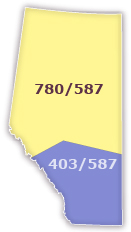
Adapted from base map
© Map Resources
Prior to 1999, the area code for the province of Alberta was 403. In 1999, another area code (780) was added and became the area code for the northern part of the province. The southern half of the province retained the 403 area code. In September 2008, Alberta added another area code, 587, across the province. Adding another area code provides the potential for 9 000 000 more phone numbers. Can you think of why the province continues to need more phone numbers?
By the end of this lesson, you will be able to show that this change does indeed amount to 9 000 000 new phone numbers.

![]() Graham/25113263/flickr
Graham/25113263/flickr
Historically, licence plates in Alberta have consisted of three letters followed by three digits. Because the province is getting short of licence-plate numbers, Alberta is now changing the format to three letters followed by four digits. In 1997, Ontario switched from three digits and three letters to four letters and three digits. Can you figure out how many new licence plates each of these scenarios will create?
Determining the number of ways in which something may occur is a branch of mathematics called combinatorics. Combinatorics is used in many ways: from designing a computer network to coding a garage door opener to determining the chances of winning the lottery.
Lesson Outcomes
At the end of this lesson you will be able to
- use the fundamental counting principle to solve problems
- use a new notation, called factorial notation, to determine numbers of arrangements of items
Lesson Questions
You will investigate the following questions:
- How can you use the fundamental counting principle to determine the number of outcomes in a given problem?
- What is factorial notation, and when is it used to solve problems?
Assessment
Your assessment may be based on a combination of the following tasks:
- completion of the Lesson 1 Assignment (Download the Lesson 1 Assignment and save it in your course folder now.)
- course folder submissions from Try This and Share activities
- additions to Glossary Terms and Formula Sheet
- work under Project Connection
Self-Check activities are for your own use. You can compare your answers to suggested answers to see if you are on track. If you are having difficulty with concepts or calculations, contact your teacher.
Remember that the questions and activities you will encounter provide you with the practice and feedback you need to successfully complete this course. You should complete all questions and place your responses in your course folder. Your teacher may wish to view your work to check on your progress and to see if you need help.
Time
Each lesson in Mathematics 30-2 Learn EveryWare is designed to be completed in approximately two hours. You may find that you require more or less time to complete individual lessons. It is important that you progress at your own pace, based on your individual learning requirements.
This time estimation does not include time required to complete Going Beyond activities or the Module Project.
1.1. Discover
Module 3: Permutations, Combinations, and the Fundamental Counting Principle
Discover
When you solved probability problems in Module 2, you had to know the total number of possible outcomes in order to determine the probability of an event. In some cases, the total number of outcomes was obvious, as in the number of cards in a deck or the number of faces on a cube. In other cases, determining the number of outcomes was more difficult.
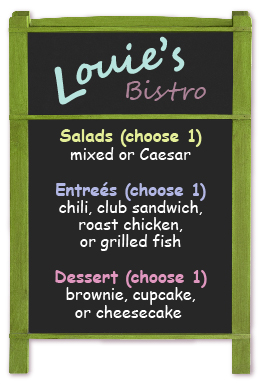
© StarJumper/19751364/Fotolia
Try This 1
Louie’s Bistro offers a special three-course meal for $20.00. You have a choice of 2 salads—mixed or Caesar—and a choice of 4 entrées: chili, club sandwich, roasted chicken, or grilled fish. Finally, for dessert, you may choose a brownie, a cupcake, or a piece of cheesecake.
How many different three-course meals are possible? ![]()
![]() Save your responses in your course folder.
Save your responses in your course folder.
Share 1
With a partner or in a group, discuss whether there is a more efficient way for determining the number of meals rather than writing out all possible meal combinations.
![]() If required, save a copy of your discussion in your course folder.
If required, save a copy of your discussion in your course folder.
1.2. Explore
Module 3: Permutations, Combinations, and the Fundamental Counting Principle
Explore
In Share 1, someone may have suggested using a diagram to solve the problem. The following diagram is called a tree diagram.
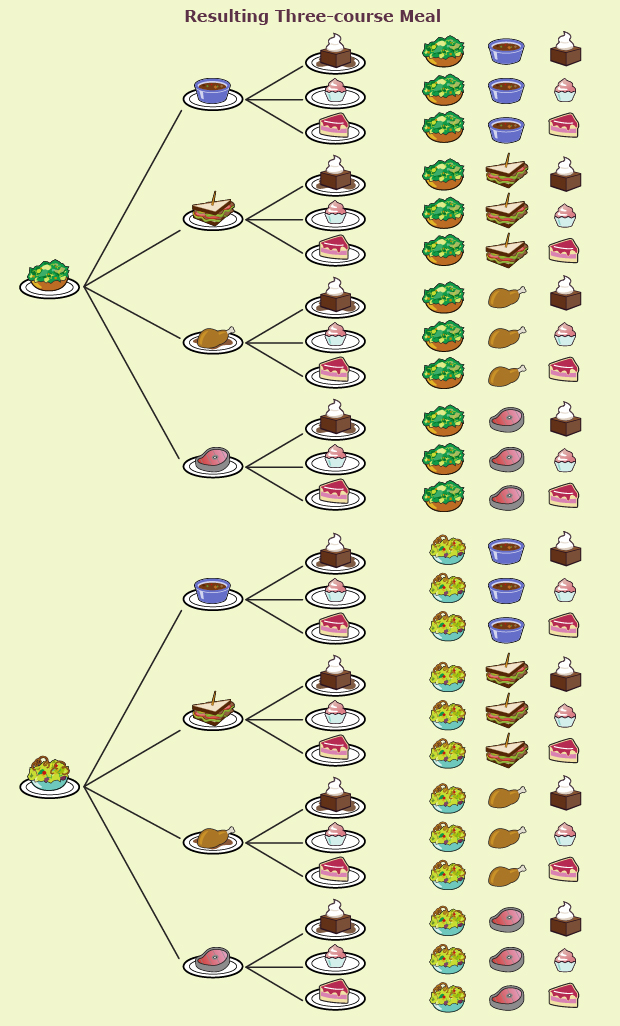
Adapted from © gollli/26357551/Fotolia
By counting the total number of terminal branches in the tree diagram, you can see that you have a choice of 24 three-course meals. The list of all 24 possible meals is called the sample space for this problem. Remember from Module 2 that the sample space is a list of all possible outcomes. You could also list all possible outcomes in an outcome table. A partial table is shown.
Salad |
Entrée |
Dessert |
mixed |
chili |
brownie |
mixed |
chili |
cupcake |
mixed |
chili |
cheesecake |
mixed |
club sandwich |
brownie |
mixed |
club sandwich |
cupcake |
mixed |
club sandwich |
cheesecake |

Hemera/Thinkstock
The first example on Tree Diagram at Mathematics Glossary demonstrates how all possible outcomes of tossing a penny and rolling a die can be calculated using a tree diagram. Note that the order of tossing the penny or rolling the die does not affect the outcomes or sample space.
In the next Try This, you will find the possible outcomes using tree diagrams and outcome tables. You will then determine an expression to calculate these outcomes.
Try This 2
Complete “Investigate the Math” questions A, B, C, D, E, F, and G on pages 66 and 67 of your textbook. ![]()
![]() Save your responses in your course folder.
Save your responses in your course folder.
1.3. Explore 2
Module 3: Permutations, Combinations, and the Fundamental Counting Principle
In “Investigate the Math” question G, which you completed as part of Try This 2, you were asked to create an expression relating the number of routes between
- Winnipeg and Regina, a
- Regina and Saskatoon, b
For each of the 3 routes between Winnipeg and Regina, there were 2 routes from Regina to Saskatoon. This is represented by a • b. That means that there were 3 × 2 or 6 ways from Winnipeg to Saskatoon, initially, and 4 × 3 or 12 ways once the new routes were added.
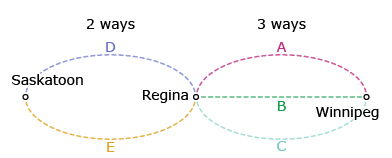
There are 3 x 2 = 6 ways to travel from Winnipeg to Saskatoon.
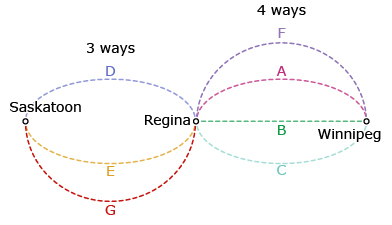
There are 4 x 3 = 12 ways to travel from Winnipeg to Saskatoon once the new routes have been added.
Think back to the example from Discover at the start of this lesson. At Louie’s Bistro, there were 2 salads, 4 entrées, and 3 desserts from which to choose a three-course meal. Using the fundamental counting principle, you can calculate the number of possible meals.
2 × 4 × 3 = 24 meals
If you would like to see another example of how a tree diagram and the fundamental counting principle are used to determine the number of outcomes, read through “Example 1” on page 68 of your textbook.
Self-Check 1
-
Kenton is choosing an outfit to wear for the day. He has a choice of 5 pairs of slacks and 8 different shirts. How many different outfits can he choose? Answer

Jupiterimages/Brand X Pictures/Thinkstock
- Use the following information to find the possible number of menu combinations.
The graduation council has been given the task of determining the menu for the graduation banquet. They have to select one salad, one main course, one side dish, one vegetable dish, and one dessert from the following choices.
- salad: Caesar, garden, tomato-herb, pasta
- main course: chicken, beef, fish
- side dish: rice, baked potato, mashed potato, French fries, noodles
- vegetable: peas, corn, carrots, mixed vegetables, broccoli
- dessert: cheesecake, pudding, ice cream, pie
Answer - How many routes are there from point A to point B if each path must take you closer to B?

Answer
![]()
- Complete “Your Turn” on page 68 of your textbook. Answer
1.4. Explore 3
Module 3: Permutations, Combinations, and the Fundamental Counting Principle
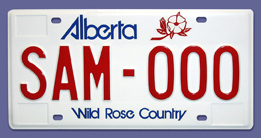
Courtesy of Alberta Motor Vehicles. Reproduced with permission
The fundamental counting principle can also be applied in situations where there are some restrictions on the choices. For example, if you want to determine the number of possible phone numbers, you need to know that you cannot use a zero as the first digit.
For many questions, there is a much more efficient way of calculating outcomes than drawing a tree diagram or creating an outcome table. Sometimes it is easier to represent a problem by drawing blanks for the outcomes. For example, how many licence plates can be made with three letters (L) followed by three digits (D)?
|
Draw blanks to represent the three letters (L) and the three digits (D) in a licence plate. |
|
There are 26 letters in the alphabet, so each of the first three blanks can be filled in 26 ways (A to Z), assuming you are allowed to repeat letters. |
|
Each of the digit blanks can be filled in 10 ways (0 to 9). |
26 × 26 × 26 × 10 × 10 × 10 = 17 576 000 |
Therefore, according to the fundamental counting principle, all of the blanks can be filled in 26 × 26 × 26 × 10 × 10 × 10 or 17 576 000 ways. |
In the next Try This, you will use blanks to help solve a problem.
Try This 3
A group of 10 children is lined up to go outside for recess. How many different ways can the children line up?
Draw 10 blanks to represent the 10 places in line.
_ _ _ _ _ _ _ _ _ _
- How many possible children could be placed in the first spot in line?
- Now that one child has been placed first in line, how many children are left that could be placed in the second spot?
- Finish determining the number of possibilities for each place in line.
- Use the fundamental counting principle to calculate the total number of ways the children can be lined up.

![]() Save your responses in your course folder.
Save your responses in your course folder.
Self-Check 2
- Consider the question about licence plates posed in the Focus section at the start of this lesson. In 2010, Ontario switched from three digits and three letters to four letters and three digits. With a partner or in a group, determine how many more licence plates are available in Ontario now with the fourth letter added. Answer
![]()
- Complete “Your Turn” on the bottom of page 69 of your textbook. Which lock has more restrictions—A or B? Explain. Answer
1.5. Expore 4
Module 3: Permutations, Combinations, and the Fundamental Counting Principle
In Try This 3, you found that you could calculate the number of ways 10 children could be lined up by finding the product of all consecutive natural numbers less than or equal to 10.
In mathematics, there is a short-cut notation for the product of a positive integer, n, and all integers less than or equal to n called factorial notation. It is denoted as n!.
Therefore, in Try This 3, students can be lined up in 10! ways.
Try This 4
To learn more about how factorial notation works, use the interactive piece titled Number of Arrangements to line up 10 students.
Self-Check 3
![]()
- Complete questions 5, 6, 7, 9, 11, 15, and 16 on pages 73 to 75 of your textbook. Answer
Add factorial notation to your copy of Glossary Terms. For each new definition in your glossary, be sure to include the appropriate notation.
Add the following formulas to your copy of Formula Sheet:
- fundamental counting principle: If there are a ways to perform one task and b ways to perform a second, independent task, then there are a • b ways for performing both tasks.
- factorial notation: n! = n(n − 1)(n − 2)…(3)(2)(1)
1.6. Connect
Module 3: Permutations, Combinations, and the Fundamental Counting Principle
Complete the Lesson 1 Assignment that you saved in your course folder at the beginning of the lesson. Show work to support your answers.
![]() Save your responses in your course folder.
Save your responses in your course folder.
Project Connection
You are ready to start working on the Module 3 Project. Go to Module 3 Project: Math Mystery. Read through Part 1 and Part 2 to discover what you will do in the project and to see how you will be assessed. At this time, only read through the project. You will begin working on the project after Lesson 2.
1.7. Lesson 1 Summary
Module 3: Permutations, Combinations, and the Fundamental Counting Principle
Lesson 1 Summary
In this lesson you learned how to determine the total number of outcomes in a sample space by using tree diagrams, outcome charts, and the fundamental counting principle. You also learned a short-cut notation called factorial notation. By using both the fundamental counting principle and factorial notation, you have seen that there are many ways to solve problems that involve arranging items and finding the possible number of combinations.
In Lesson 2 you will investigate and learn how factorial notation can be used to solve more complex problems.

